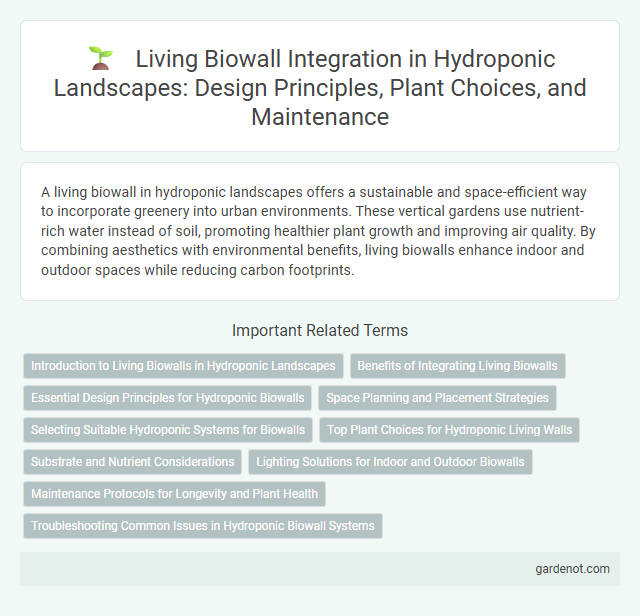A living biowall in hydroponic landscapes offers a sustainable and space-efficient way to incorporate greenery into urban environments. These vertical gardens use nutrient-rich water instead of soil, promoting healthier plant growth and improving air quality. By combining aesthetics with environmental benefits, living biowalls enhance indoor and outdoor spaces while reducing carbon footprints.
Introduction to Living Biowalls in Hydroponic Landscapes
Living biowalls in hydroponic landscapes utilize vertical structures embedded with nutrient-rich water systems to support plant growth without soil. These biowalls enhance air quality, promote biodiversity, and offer sustainable solutions for urban environments by incorporating a variety of drought-tolerant and native plant species. Advanced hydroponic technology ensures optimal hydration and nutrient delivery, resulting in vibrant, low-maintenance green walls that improve aesthetic appeal and environmental health.
Benefits of Integrating Living Biowalls
Living biowalls enhance hydroponic landscapes by improving air quality through natural filtration and oxygenation. They contribute to energy efficiency by cooling indoor environments and reducing reliance on artificial climate control. Integrating living biowalls also boosts aesthetic appeal and promotes biodiversity, creating sustainable green spaces within urban settings.
Essential Design Principles for Hydroponic Biowalls
Living biowalls require optimal water circulation to ensure nutrient delivery and prevent root rot, making efficient hydroponic systems essential for sustained plant health. Selecting shade-tolerant, high-transpiration plants enhances microclimate regulation and air purification within indoor environments. Structural support with lightweight, durable materials guarantees long-term stability while facilitating maintenance access and irrigation system integration.
Space Planning and Placement Strategies
Living biowalls in hydroponic landscapes enhance vertical greening while maximizing limited space through strategic placement. Optimal space planning involves assessing light exposure, humidity, and airflow to support plant health and system efficiency. Positioning biowalls near natural light sources or integrating artificial grow lights ensures balanced photosynthesis and aesthetic appeal in indoor environments.
Selecting Suitable Hydroponic Systems for Biowalls
Choosing suitable hydroponic systems for living biowalls depends on factors like plant species, nutrient delivery efficiency, and system maintenance requirements. Nutrient film technique (NFT) and ebb and flow systems provide consistent hydration and oxygenation critical for healthy biowall growth. Emphasizing modular, scalable designs ensures adaptability to various indoor and outdoor environments while optimizing space and resource utilization.
Top Plant Choices for Hydroponic Living Walls
Epipremnum aureum, Ficus pumila, and Philodendron scandens thrive in hydroponic living biowalls due to their adaptability and robust root systems. Pothos varieties exhibit rapid growth and air-purifying qualities, enhancing indoor air quality. Ferns like Nephrolepis exaltata also contribute moisture regulation and aesthetic texture to hydroponic vertical gardens.
Substrate and Nutrient Considerations
Living biowalls in hydroponic landscapes require carefully selected substrates such as volcanic rock, coconut coir, or perlite to provide optimal root aeration and water retention. Nutrient solutions must be precisely balanced with essential macroelements like nitrogen, phosphorus, and potassium, alongside micronutrients including iron, magnesium, and calcium to promote vigorous plant growth. Consistent monitoring of pH levels between 5.5 and 6.5 ensures maximum nutrient availability and efficient uptake in the hydroponic biowall system.
Lighting Solutions for Indoor and Outdoor Biowalls
Lighting solutions for indoor and outdoor living biowalls enhance plant growth through adjustable LED systems tailored to specific light wavelengths, promoting photosynthesis and vibrant foliage. Outdoor biowalls utilize weather-resistant fixtures with optimized light diffusion to maintain uniform illumination under varying environmental conditions. Integration of smart lighting controls ensures energy efficiency and adapts light intensity based on ambient natural light levels, maximizing biowall health and aesthetic appeal.
Maintenance Protocols for Longevity and Plant Health
Living biowalls in hydroponic landscapes require regular monitoring of nutrient levels, pH balance, and moisture to ensure optimal plant health and system longevity. Implementing a maintenance protocol that includes periodic cleaning of water reservoirs, pruning of plant material, and inspection for pest infestations helps sustain the biowall's functionality and aesthetic appeal. Employing automated irrigation systems with sensors can enhance precision, reducing resource waste and promoting consistent growth conditions for the living biowall.
Troubleshooting Common Issues in Hydroponic Biowall Systems
Troubleshooting common issues in hydroponic biowall systems involves addressing nutrient imbalances, water circulation problems, and pest infestations. Monitoring pH levels between 5.5 and 6.5 ensures optimal nutrient uptake, while maintaining proper water flow prevents root rot and promotes healthy plant growth. Implementing integrated pest management strategies helps control common pests such as aphids and spider mites without disrupting the delicate hydroponic environment.
Living biowall Infographic

 gardenot.com
gardenot.com